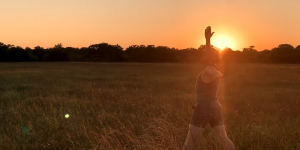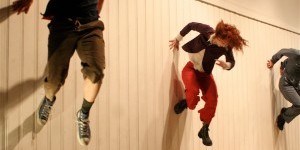IMPRESSIONS: Matthew Westerby Company at the Murray Haber Theatre, Hudson Guild

Matthew Westerby Company
Murray Haber Theatre at Hudson Guild in Chelsea
Choreographer: Matthew Westerby
Lighting designer: Grady Shea
Musicians: John P. Hastings, Bryan Senti, Radical Fashion, Ben Frost, Ben Lukas Noysen, Nils Frahm
Costume designer: Kristin Licata, Hana Ginsburg Tirosh, Matthew Westerby
Performers: Dylan Baker, Caitlyn Casson, Sidney Choothesa, Hana Ginsburg Tirosh, Erin Giordano, Misaki Hayama, Nicole Kadar-Greene, Kristin Licata, Daniel Morimoto, Jack Murphy, Mar Undag, Lauren Aureus, Crystavia Clark, Emanuele Fiore, Alexzander Larson, Emily Sanchez, Yoshi Sanders, Nadia Simmons, Maile Yoon
April 24 - 27, 2020
Choreographer Matthew Westerby opened the evening at the Murray Haber Theatre at Hudson Guild in Chelsea, with a call to action, speaking of outreach, education, equity, and inclusion.
“Now is the time,” he said, “to uplift our communities, to champion their strengths, and to stand firm in defense of the rights of LGBTQ people, women, and the vulnerable.”

That sense of community resonated through the succinct choreography: in the dancers intertwining paths, the cooperation of large groups on a small stage, and in the way each performer was given space to be seen. The program featured eight dances, with a revolving cast of 20 that included the second company, MWC 2. The works were created between 2021 and 2025, apart from Slow Fall (2008), performed by Westerby and Caitlyn Casson.
Mid-career, Westerby remains a vigorous example of his own challenging movement vocabulary, characterized by swings, extensions, and turns in wide-reaching spirals. The exceptional Casson embodied the tension and despair that develop between people who vie for control.
.jpg)
The premieres When at First, They Came For Me and Out Here, in the Middle served as powerful bookends to the third premiere, Womanhood, the most distinctive work on the program.
With text spoken in a tincture of low register and stand-firm power by actor L.A. Brown, and Erin Giordano’s clear and supple dancing, Womanhood stood out for its exclamation of identity. One charming moment found Brown chuckling as Giordano subtly lifted her eyebrows. The rhythm of the spoken word score, written by Westerby with contributions from thirteen women, was mirrored in movement that conveyed pain, the relentless pressure to prove oneself, and the unwavering control over one’s body.
“It’s my body, my choice, and it all belongs to me,” says Brown, while both performers gaze outward, hands pressed to their chests.

The other duet of note, an excerpt of the 40-minute Piers (2021) performed by the dynamic Dylan Baker and physically articulate Jack Murphy, began with their backs to the audience. Shifting downstage to upstage and back again, they seemed to be questioning their partnership. When they reconcile, Murphy climbs into Baker’s arms until Baker is pulled onto the diagonal. They stay close, leaning on one another so that if one moves, the other falls. Ultimately irreconcilable, they push away and separate.
Opening the program, When at First They Came For Me evokes the unease of a world where lives are disrupted, where citizens and immigrants alike can be plucked from ordinary existence and thrown into uncertainty. Set to an uneven original score by John P. Hastings, the piece begins with six dancers of similar height forming a rotating line, orbiting a central axis. One by one, they drop away and return, repeating a pattern of leaving and coming back. The pulsing sound accompanies the group as they freeze into two lines. Baker thrusts his head into the stomach of a female dancer, then manipulates her limbs like a puppet, as if stripping her of will. Later, Baker and another dancer come together, resting forehead to forehead, a quiet gesture that suggests understanding and solace. When a citizen is stripped of rights, this dance summarizes their situation.
%20Sidney%20Choothesa%2C%20Dylan%20Baker%2C%20Hana%20Ginsburg%20Tirosh%2C%20Caitlyn%20Casson.jpg)
While the physical vocabulary remained largely within familiar confines, its clarity, flow and generosity were undeniable. Full-bodied swings, leg extensions unfurling mid-jump, and gestures radiating from the dancers’ kinespheres revealed a heightened understanding of momentum and phrasing. Arms reached, circled, and pushed away with flexed wrists. Dancers constantly shifted, their pairings dissolving and reforming in a kaleidoscopic pattern, all supported by Grady Shea’s evocative lighting. The movement was never forced.
Given that many of Westerby's dancers have been with the company for well over a decade, Westerby is doing something more than right. Indeed, the dancers exuded pure pleasure, carried by the flow of the group, and some even smiled —a rare sight in a dance performance. In that simple, genuine expression, the audience was reminded of the joy that lies at the heart of community, and the power of dance to reflect it.











